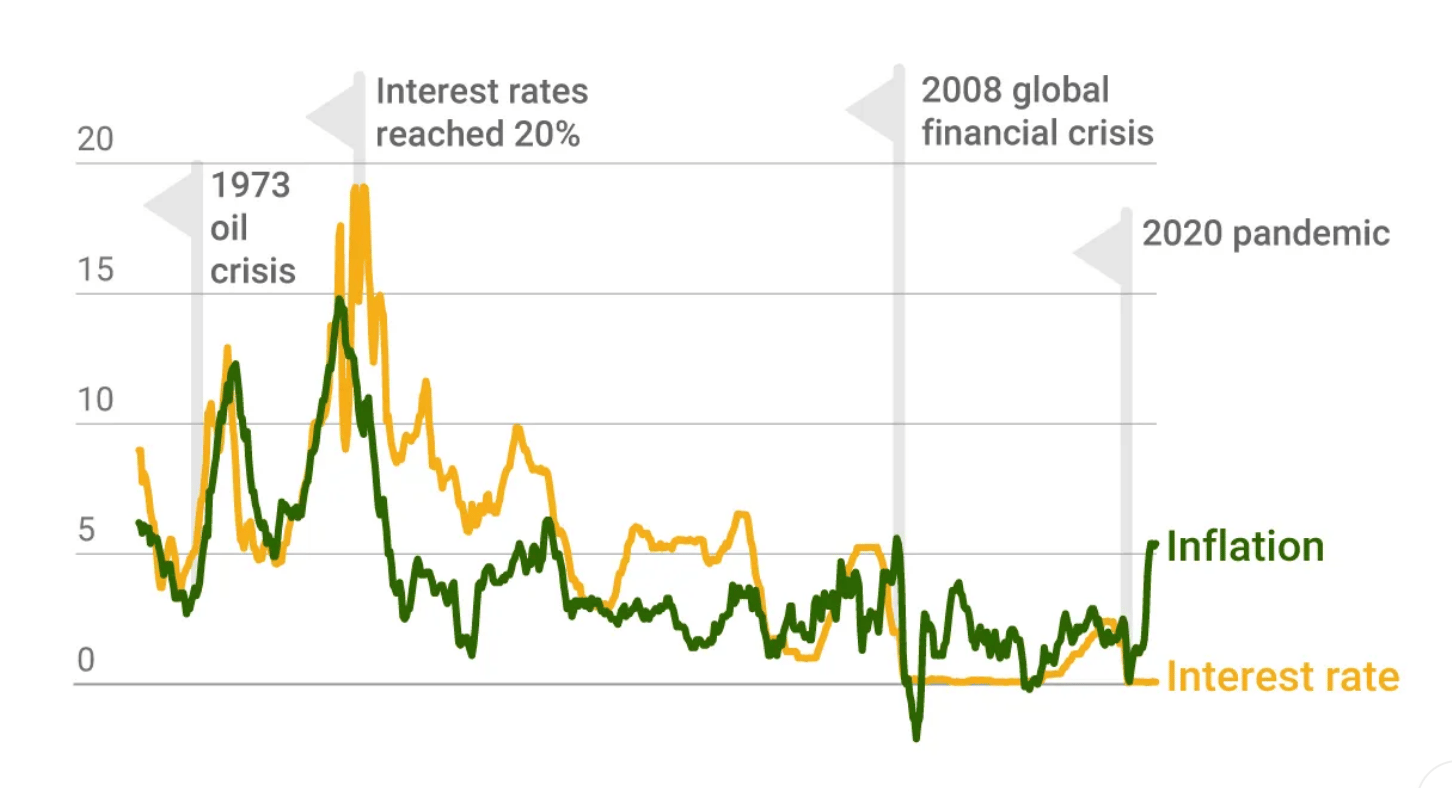
Comparing inflation rates and Fed fund rates.
Key terms
Interest rate: The amount of money a lender or creditor charges for access to money.
Federal funds rate: The interest rate that financial institutions charge each other for loans in the overnight market for reserves.
Inflation: The rate at which prices for goods and services increase.
The Federal Reserve: The central bank of the United States that is charged to maintain a stable economy and financial system.
FOMC: Committee within the Federal Reserve System that meets to make key decisions about interest rates and the growth of the US money supply.
Takeaways
The federal funds rate is the target interest rate set by the Federal Reserve.
The federal funds rate directly influences short-term rates on consumer loans and credit cards.
Inflation is a measure of purchasing power. It's defined as the rate at which the prices of products and services change.A quarter-of-a-point move may not seem like much, but it can affect your living situation, student loans and job prospects. One institution impacts the smallest of your financial decisions: The Federal Reserve. As inflation surpasses 40-year highs in the United States, it's important to understand the Federal Reserve's impact on inflation and your trades.
Interest rates
An interest rate is the amount of money a lender or creditor charges for access to money. Inflation and interest rates tend to move in the same direction, with one often chasing the other as they rise and fall. That's because interest rates are the primary tool used by the Federal Reserve to manage inflation. The relationship mirrors basic supply and demand principles.
The Federal Reserve
The Federal Reserve is the central bank of the United States and is charged by Congress to maintain a stable economy and financial system. One of the ways the Fed does this is by increasing and lowering the cost of borrowing money. Interest rate cuts are intended to encourage more borrowing and spending by people and companies. That spending, in turn, tends to accelerate growth and energize economies.
For example, lower mortgage rates typically lift home sales. Cheaper borrowing can lead businesses to take out loans, expand and hire. Conversely, interest rate increases help contain inflation as consumers spend less when the cost of borrowing rises.
The Federal funds rate is one of the most important interest rates in the U.S. economy. That's because it affects monetary and financial conditions, which in turn have a bearing on critical aspects of the broader economy including employment, growth, and inflation.
The Federal funds rate is a type of interest rate. The chief distinction is that the federal funds rate sets the range that banks will lend or borrow to each other overnight. Because this impacts borrowing costs and financial conditions, stock markets are typically sensitive to changes in these rates. The federal funds rate also indirectly affects short-term interest rates. Conversely, interest rates, which are set by the Federal Reserve, determine the rate that it costs for banks to borrow.
It is customary for the Federal Open Market Committee (FOMC) to meet eight times annually to determine the federal funds rate. These rates are influenced by economic indicators, such as the core inflation rate and the durable goods orders report, which provide signals about the economic health of the country.
Investors keep a close watch on the federal funds rate. The stock market typically reacts very strongly to changes in the target rate. For example, a small decline in the rate can prompt the market to leap higher as the borrowing costs for companies get lower. Many stock analysts pay particular attention to statements by members of the FOMC to try to get a sense of where the target rate may be headed.

Inflation and the role of the Fed
Inflation is a measure of purchasing power. It's defined as the rate at which the prices of products and services change. When inflation is running high or when the economy is experiencing a major slowdown, one of the primary ways the Fed works to get things back in order is through the federal funds rate.
The rate of inflation influences the direction of interest rates and, conversely, interest rates influence the direction of inflation. If inflation is high, interest rates will typically be raised by the U.S. Federal Reserve to slow economic growth. If inflation is low, economic growth is generally low, and a decrease in rates is enacted in order to lower the cost of borrowing and to spur economic growth.
More borrowing power can lead to spending, a stronger economy and, ultimately, inflation. The U.S. Federal Reserve has the task of finding the right balance of tweaking interest rates to manage growth and keeping unemployment low and wages high. The Federal Reserve also has to avoid promoting too much growth, which could lead to high inflation. The Fed generally tries to keep inflation within the 2%-3% range.
Inflation is measured using several different price sources, with the U.S. Consumer Price Index (CPI) and the Producer Price Index (PPI) being two of the core metrics. The CPI measures the price changes in consumer goods and services. Prices on goods like cars, clothing and food are measured from the purchaser's point of view. The PPI measures the price changes in goods and services by domestic producers from the seller's viewpoint. Both indices are calculated monthly and data is produced by the U.S. Bureau of Labor Statistics.